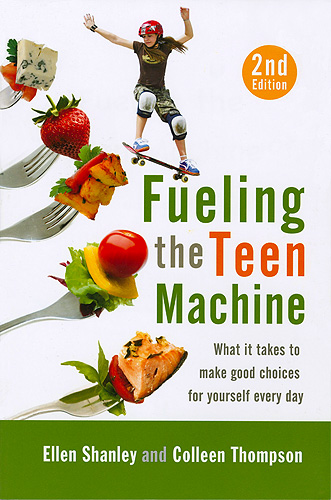 Convincing teenagers to think about what they eat may be a daunting task, but UConn co-authors Ellen Shanley, director of the Dietetics Program in the Department of Allied Health Sciences, and Colleen Thompson, director of the Hawley Armory Fitness and Wellness Programs, aim to do just that with the new second edition of their book, Fueling the Teen Machine.
Convincing teenagers to think about what they eat may be a daunting task, but UConn co-authors Ellen Shanley, director of the Dietetics Program in the Department of Allied Health Sciences, and Colleen Thompson, director of the Hawley Armory Fitness and Wellness Programs, aim to do just that with the new second edition of their book, Fueling the Teen Machine.
The first edition began as part of a USDA grant in collaboration with the Connecticut State Department of Education. As Shanley and Thompson worked with family and consumer science teachers throughout the state on a nutrition guide for teens, the project grew to book length and was published in 2001 by Bull Publishing. As the book continued to be successful, Bull Publishing approached the team to write a second edition.
“This book is really fresh,” says Shanley. “It’s designed for kids to read themselves, written in a friendly and conversational tone.”
Adds Thompson, “We focus on what matters to teens – eating healthy to feel well, and to succeed in school and sports.”
The second edition required a major rewrite, and it incorporates many of the newest issues in dietary health, including the new food pyramid, weight management, eating disorders, sports nutrition, vegetarianism, and physical activity.
One of the hot topics included in the book is superfoods, or foods that are nutritionally concentrated, such as beans, nuts, soy, pomegranate, sweet potato, oats, and quinoa. Recipes and cooking instructions appeal to the teen’s sense of independence.
“We’re trying to get kids hooked on cooking and encourage families back into the kitchen,” Thompson says.
The target audience is teens ages 12 to 18. “During middle school, kids begin to change their eating habits,” says Thompson. “It’s the age where they are more involved in choosing their own food.”
The new edition, unveiled in November at the American Dietetic Association Annual Conference in Boston, has received a positive review from the online publication The Healthy Moms Magazine.
The duo work well together, combining expertise not only as dietitians, but also as mothers of teens. Shanley’s two children were teenagers when the first edition was written, while Thompson’s three children currently range in age from 12 to 19.
“We each take primary responsibility for particular chapters, and then edit the other’s,” says Shanley. “We share the same philosophy, which made this very easy to do.”
The two also co-wrote Overcoming Childhood Obesity (Bull, 2004).


